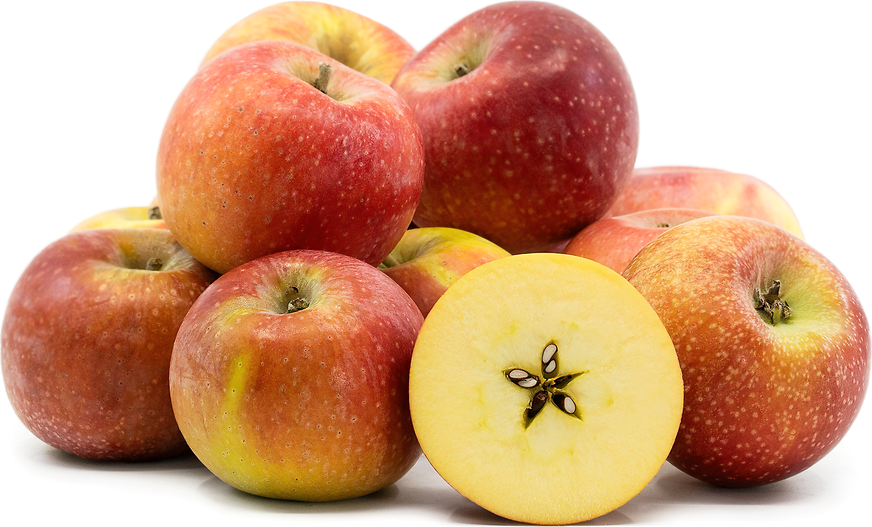


Hauer Pippin Apples
Estimated Inventory, lb : 0
This item was last sold on : 12/03/22
Description/Taste
Hauer Pippin apples are medium to large fruits, averaging 7 to 9 centimeters in diameter, and have a flattened, round to conical shape. The skin is thick, chewy, smooth, and matte with a yellow-green base, covered in a dull, dark red blush. The skin also features prominent grey-brown lenticels and a small patch of tan russet surrounding the stem. Underneath the surface, the cream-colored flesh is crisp, dense, fine-grained, and aqueous, encasing a small, central core filled with oval, black-brown seeds. It is important to note that when the flesh is exposed to air, the surface oxidizes quickly, developing brown hues. Hauer Pippin apples contain a high sugar content and low acidity, creating a balanced sweet-tart flavor with notes of cinnamon, clove, green apple, and grapes.
Seasons/Availability
Hauer Pippin apples are available in the winter through early spring.
Current Facts
Hauer Pippin apples, botanically classified as Malus domestica, are a rare heirloom variety belonging to the Rosaceae family. The sweet-tart fruits are a late-season cultivar that was first released in Santa Cruz County, California, in the 1890s. Hauer Pippin apples are one of the latest winter varieties to arrive at commercial markets and have excellent storage life, making them suitable for consumption through the early spring. The variety’s long storage life is what initially propelled the cultivar to fame in Northern California during the early 20th century, but as refrigeration began to extend the freshness of thinner-skinned apples, creating more competition, Hauer Pippin apples were replaced with newer, modern varieties with aesthetically pleasing appearances. In the modern-day, Hauer Pippin apples are an uncommon, novel variety favored as a multi-purpose apple, consumed in fresh, baked, and cooked applications.
Nutritional Value
Hauer Pippin apples are a good source of fiber to regulate the digestive tract and contain vitamins A and C, antioxidants that strengthen the immune system while reducing inflammation. The apples also provide lower amounts of potassium, manganese, phosphorus, and vitamin K.
Applications
Hauer Pippin apples have a balanced, sweet-tart flavor that lends itself well to both fresh and cooked applications such as baking, roasting, and simmering. The fruits can be eaten straight, out-of-hand, or they can be sliced into fruit bowls, tossed into green salads, or quartered and served with nut butter as a snack. Hauer Pippin apples are also popularly pressed, and the sharp juice is used to flavor cocktails, cider, and apple juice. Beyond fresh applications, Hauer Pippin apples hold their shape well when cooked and can be hollowed, stuffed with nuts, and baked, sliced and roasted, or cooked into applesauce to pair with roasted meats. Hauer Pippin apples can also be baked into tarts, pies, cakes, muffins, and bread, stirred into cobblers and crumbles, or simmered into apple butter, jams, jellies, and preserves. Hauer Pippin apples pair well with vanilla, spices such as cinnamon, cloves, allspice, cardamom, and nutmeg, fruits such as blueberries, pears, apricots, and cranberries, and nuts such as hazelnut, pistachios, walnuts, and pecans. Whole Hauer Pippin apples will keep 2 to 3 months when stored in the crisper drawer of the refrigerator.
Ethnic/Cultural Info
Hauer Pippin apples were initially named Hauer “Special” apples by founder Peter Hauer and were one of the most popular varieties in San Francisco in the 1930s. The cultivar was favored for its extended storage capabilities and late-season arrival, allowing the fruits to be easily kept throughout the winter season without the need for refrigeration. Hauer “Special” apples were also heavily marketed for holiday baking, ciders, and roasts, labeled as the Christmas Apple. In the height of the cultivar’s popularity, it was rumored that Hauer’s apple orchard transformed from a small site to one of the largest orchards along the West Coast, supplying solely Hauer “Special” apples. In addition to local markets, Hauer “Special” apples were also frequently shipped to England through the Panama Canal and sold as a rare, luxury variety.
Geography/History
Hauer Pippin apples were grown by Peter Hauer in the late 1890s at a nursery near Aptos in Santa Cruz County, California. The history of the variety began with Hauer discovering a yellow bellflower apple seedling growing on his property in Pleasant Valley, California. Hauer took the tree to Claus Speckle’s nursery in Aptos and worked with his brother to graft and experiment on the newfound seedling. After multiple trials, the grafted cultivar that took best to the tree was a cox orange pippin that Hauer had ordered from Australia. Hauer Pippin apples are believed to be a hybrid between the cox orange pippin apple and the yellow bellflower apple. The variety was widely cultivated in Northern California during the early 20th century, but with technological advancements, Hauer Pippin apples slowly fell out of favor for more aesthetically attractive varieties. Hauer Pippin apples almost disappeared entirely in the early 21st century and were listed on Slow Food’s Ark of Taste in 2009, a catalog of varieties in danger of extinction. Efforts through specialty orchards in the Pajaro Valley, California, have helped promote the variety for regional farm cultivation. Today, Hauer Pippin apples are grown through a few orchards in Santa Cruz County for sale at farmer’s markets.
Recipe Ideas
Recipes that include Hauer Pippin Apples. One




